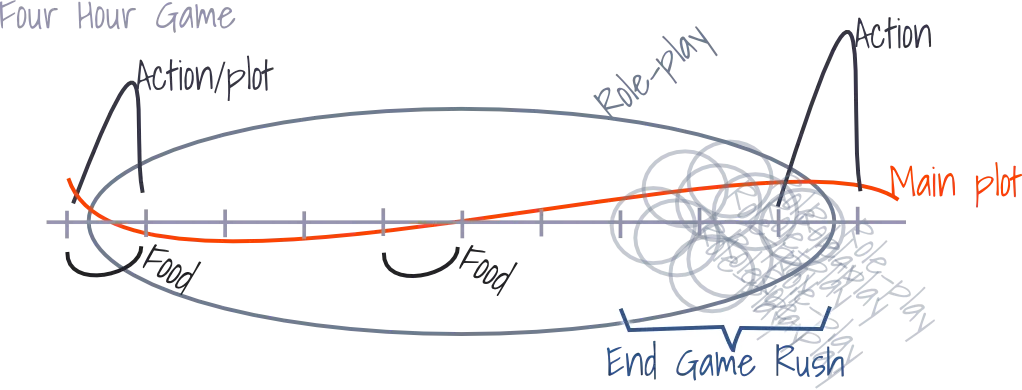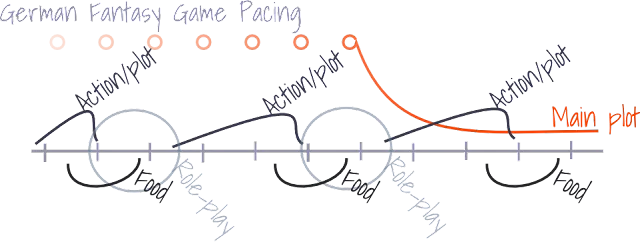Terror at noon!
One of the stolen ideas explored in Perintö 19631 was foreshadowing [horror] by openly communicating the schedule and pacing of the game.
The gentle touch of pacing
The most apparent difference between a typical Finnish larp and [some of the sampled] German fantasy games is duration. And duration’s effect on the amount of required pacing. A standard Finnish four-hour game does not really need any pacing at all.

Skipping the pacing causes a phenomenon known as the end-game rush, as players try to fit all their characters’ drama into the last hour or half an hour. Usually, this does not affect player experience as the end game rush is harmless for the four-hour games. Many players recognize the phenomenon and tend to see it more as a nuisance than a design flaw.
The picture changes when considering much longer games prevalent in the German scene. If the game lasts more than a day, a schedule and finely-tuned pacing are things you really have to do. And do well.
Using the same level of abstraction as above. The German fantasy games have a simple but highly efficient structure spanning the multi-day larp.

Plot and action scenes are always followed by breaks with the ability to eat and rest. Following the “break,” players have reasonable time to experience and play their characters. These three game modes often overlap, so players can just do action/plots and eat or role-play and eat. (the view presented here is simplified for the article’s sake).
Another interesting fact is the main plot. Even though there might be some main plot-related puzzles, quests, or hints, it rarely starts to roll before the finale.
The Terrible Experiment
Looking at the German fantasy game pacing, it seemed to offer a way to mitigate some of Perintö 1963’s central design challenges:
- Immersion into game setting and player character takes time
- Terror/Horror can be more effective if it is unknown and/or breaks the normal flow of life/game
These design challenges were presented more clearly by Joc Koljonen in her Solmukohta 2012 presentation on Ghost Stories (order reversed to match Joc’s slides):
- Game time limitations and narrative expectations make establishing the ordinary relatively tricky.
- Immersion into another era/environment eats up more of this limited time.
The German fantasy game pacing does not offer a simple resolution to both challenges. The establishing of era/environment and immersion to character happens much more effectively with the German pacing than with the long-stale-wait and end-game-rush method. And suppose we combine it with the fact that most German players know the structure instinctively. Those assumptions get us pretty close to a workable solution, which we succesfully used for Perintö 1963: The schedule and pacing of the game (esp. the murder mystery and supernatural plots) were modeled after a German modern fantasy [Cthulhu] game KultUr II and presented to the players before the game in an abstract form.
Where German players might have guessed that the main plot finale starts on the last night or noon of the final day, players of Perintö were told the same clearly in briefs and start-up sessions: “Nothing special or supernatural will happen before the next day’s morning [except the nightly dream scenarios]. ” Players were also told to expect something on the next day. Something mysterious and terrible.
To counter the possible spoiler aspects of the open schedule, only principles of the method and vague pacing of the game were given to the players. The possibility of variations was discussed broadly, and every player was given the same information. Keeping to the minimum detail needed enabled Game Masters to run the game with the feeling of hidden mysteries and creeping terror.
In essence, the method detailed above works as intended. The openly communicated schedule allows players to get into the game’s flow at their own pace and – more essentially – establish the game’s era and setting before anything starts to happen. Further on, this enables game masters to break the mundane atmosphere with horror/terror at will.
After the horror?
A working example does add to the plausibility of the method. However, it does not mean the technique is a repeatable silver bullet to the presented challenges. The success of terror/horror plots of the game might have something to do with other methods used in the game or with the players and their experience and attitudes.
Caveat lector: This text was adapted from my older game-design blog, and it’s language was re-proofed with modern tooling.
Footnotes
-
A Finnish larp about a family reunion in 1963, and supernatural occurences there. The game was run in 2013. ↩